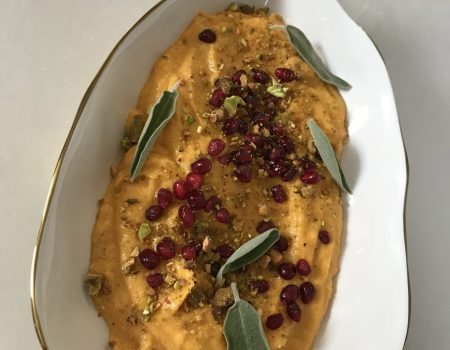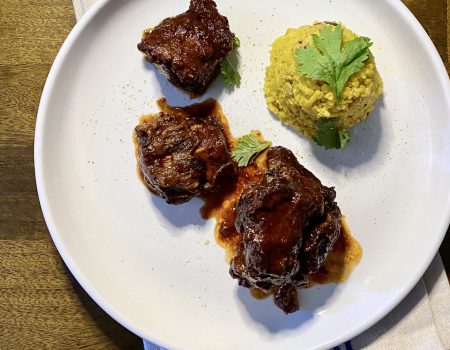
(picture taken from Food, Inc.’s official site)
I finally watched Food, Inc.
Ever since my DC-friend Kim O’Donnel recapped it while she was at The Washington Post, I’ve thought about it, watched previews and did some reading on all the points the documentary touches. However, I reserved room not to watch it simply because I wasn’t ready to accept the undeniable truth.
And, I wanted to continue with my eating habits. In my opinion, they were perfectly fine, including the occasional ice cream bath and daily honey & milk splurge.
So, I sipped on Spanish wine, sat back and watched the documentary.
(Trailer; pic of a Latin family, challenged with choosing vegetables or burgers)
A lot of the imparted information was not news to me, though seeing it in living color gave those facts a different element of disturbia. Other parts were jaw dropping. I won’t go into politics here, but to have 4 major food meat packing companies control 80% of American distribution, defies the principles of free commerce and open competition. My conclusion was that those companies are in bed with each other and have formed an alliance to keep the farming industry suppressed and dependent.
The GM (or GMO) debate is most astonishing. I’ve heard this term in the last 5 years, but never gave it real attention. For those of you that don’t know, GMO’s are genetically mutated organisms. Their purpose is multi-faceted. Some farmers, bio-engineers and scientists argue for the use of GMO’s in our crops for its growth potential, vitamin enhancing potential and herbicide protection (among others). In fact, the argument is so strong, I read (during brief research) that a “gold” grain of rice is being created that will have high properties of beta-karotene and Vitamin A. This “gold” strain was inspired in part, by concerns of blindness seen in 3 world countries where the population relies mostly on crops such as rice.
In 2006 (looking for more recent data), 252 million acres of transgenic crops were planted in 22 countries by 10.3 million farmers. The majority of these crops were herbicide- and insect-resistant, including, soybeans, corn, cotton, canola, and alfalfa (according to the Human Genome Project, sponsored by the government).
This means that mostly everything we buy and eat has a high chance of having GMO’s in it. Our federal government doesn’t mandate label disclosure of GMO presence in food. But, if you consider that most foods have some corn derivative, we can safely assume there is some percentage of GMO’s. The corn situation is an entirely different conversation.
If you look at the labels that are placed, specifically on produce, many of them say “product of this country or that country.” So, food that was once unavailable in the States because it’s not in season, is now available from other countries. That adds an additional unknown factor, albeit my personal interest in accessing international food is strong and practical. The question is, do we know these countries’ seeding practices. Probably not. But, we too have started to produce and offer fruits and vegetables that are not year-round seeds. One of the “positives” listed in many of the papers I read, stated that these mutated organisms enhanced flavor and the aesthetic of crops and plants. An example would be the tomato, a fruit that naturally harvests in summer. However, we all know that you can go to the grocery store and buy a large variety of different tomatoes, year-round. That’s disturbing. Yes, they’re pretty and chunky, but at the expense of putting something in my body that has not been scientifically proven NOT to have long term effects.
As for the enhanced taste of these crops, the opposition, which I’m clearly falling to, can argue that we grow to like what we’re given every day. Even if we don’t necessarily like it, we adapt. Therefore, if we’ve been eating (and possibly, ONLY been eating) a super red, juicy tomato that’s ripened to perfection, naturally our taste buds might reject a natural, organic one we’re not accustomed to biting.
Opposing arguments are just as strong but pale in comparison when you consider the growing number of food companies that distribute GMO foods. Among the concerns are long term health effects on the human body. In fact, some research (as reported by CSA) showed that Monarch butterflies died after being introduced to GMO’s in certain plants.
The arguments go beyond human health and are just as important.
Kim shared the following video with me. She calls it the “ABC’s of GMO’s,” part of a series by scientist Bill Nye.
Editorial note 8/1/10: Shortly after I published this post, the video above was been removed from Youtube. I wonder.
But, I went back to Youtube and found incredible footage and additional documentaries and feature films on the dangers and global debate of GMO’s. I fount the following one to be pretty though-provoking (though, there was another one that really puts the issue in your face). I’d love your thoughts.
After some preliminary research, I’m still not certain on all the ins and outs of the GMO practice. However, what I did learn was enough for me to be even more conscious and start changing my eating habits, again.
What do you and I do?
Be informed, read packaging and talk to your grocery stores’ produce manager and ask him/her questions about the source of the produce and foods being sold there. As your friend, I challenge you to go further and eat local, sustainable food, if you’re not already. Do research on your local farmers and develop a relationship with them. Ask them about their planting and feeding practices. Ask them where they resource their seeds from. Think smaller, not bigger, in this instance. In talking to just two local farmers outside Atlanta, I felt the genuine and transparent approach to producing healthy, viable and true food. Food that I can peacefully eat.
It’s worth miles. Treat your body right.

Eat well, love unapologetically, pray with true intention, and take care of yourself.
















80 thoughts on “What is the Truth About GMO's?”
I must comment that I can definitely tell the difference between an in-season tomato and an out-of-season tomato. I love in-season; out-of-season has no flavor in comparison.
I’m starting to feel a bit cynical about all of this. Before it was “don’t eat processed foods”. Now it’s “don’t eat fruits, veggies and meats because of GMO”. I have not done any reading up so I am completely ignorant, but still.
Great work Bren! This is a wonderful review of the movie, and where to go from there. These are subjects that I am very passionate about, and like you don’t have the scientific knowledge to fully understand it all. But I have decided to opt out anyway, which is why we are growing a lot of our own food this year, including chickens and when we can’t we are shopping at the farmers market. We get very little besides paper products and toiletries (and even less of them than we used to) from the grocery store. It take a while to adapt, but I can tell you that it makes a world of difference. Not only in the way we feel, but in our impact on the local economy.
A very interesting review! Here, in Europe, GMO are a big subject since years… It is something that is being forced on us without our consent. GMO are destroying nature (see disappearing bees, etc…).
Cheers,
Rosa
The whole GMO thing is a tad tricky… We’ve been modifying foods genetically since we began agriculture. It’s more the scale and speed that are different now. The impact of a mistake that was localized now could spread globally. And rather than small changes over the course of years to which nature could react, we shock ecosystems with a massive influx.
So it’s the fast, large-scale modifications that are a potential problem. That we’ve lumped everything into one category somewhat helps the pro-GMO folks, because they can explain that we’ve always modified plants and leave out the unfortunate details.
And GMO isn’t always bad, either. Semi-dwarf wheat and rice varieties staved off famine in India during the 1960s.
The whole issue is tricky on the ecological side. The business side is where the problems lurk. Monsanto (Con-Agra) is a frightful corporation. They sell poisons and “poison-resistant” crops that wreck havoc on natural systems. Ecologically, that ends up causing a monoculture *and* accelerating changes in pests. Similar effects are being observed in health; our current antibiotic frenzy may be causing the super-diseases by allowing only those diseases to survive. Economically, the monoculture leads to monopoly power.
The in-season and out-of-season issue is a bit more clear, simply because much out-of-season produce is shipped from that reverse hemisphere, and the shipping uses oil… That has a more obvious impact. Or, in the case of tomatoes, the fruits never were ripe. They were ripened artificially close to the destination because ripe fruits just don’t transport well.
Very interesting read. As a society I think we take too much at face value. I applaud you for challenging and encouraging your readers to put a little more thought into what they are putting into their bodies.
Great post! Thanks
Jason, I appreciate your input, but some of your information is a bit askew, as there were no GMO crops in the ’60s. Now we can debate whether traditional crossbreeding is genetic manipulation in the same sense as transgenic genetic modification(GMO) but the only way you could prevail is if we agree that removing a splinter from your thumb is surgery on a plane equal to the neurosurgeon that removed the tumor from my right parietal lobe, but frankly that would be intellectually dishonest. To date, not a single GMO introduced commercially has come anywhere near living up to the hype by which it was sold. There have been many instances of increased yield, to be sure, but these have all come at increased price for the initial seed and specialized( and attending by legally binding contract)inputs which have proven to have a host of negative consequences for the farmer, consumer and the environment.
Your analogy is apt if you blindfold the surgeon (very few full sequences or protein structures, almost no functional information), spin the surgeon around a few dozen times (incredible number of errors in existing data), and equip the surgeon with a sledgehammer (must work in bulk because little actually occurs correctly). I know a bit of the field.
GMO stands for “genetically modified organism.” Its application only to direct genetic modifications is recent, and that application covers protein sequences as well as genetic material. The cisgenic modifications can be just as dangerous as transgenic, too, so don’t get hung up on transgenic.
Transgenic modification of plants does *not* require low-level techniques and has been around a long, long time. Consider pluots. There are many species of plums, and many species of apricots. Some have been crossed into pluots, others into apriums. Similarly, falcon breeders have produced hybrid (and sterile, btw) birds by crossing species. Both of those technically are transgenically modified organisms that have been around long before the 60s. Viruses are naturally occurring transgenic operators. The differences here are speed and locality. Natural crossing takes time and sits in a small place, giving natural responses time to react.
And when you say none of the commercial GMOs have lived up to their hype, you’ve listened to the *wrong hype*. They very much have lived up to the hype on their quantity and lower production costs. That is how they’re sold to the mass farms. Nothing about health benefits or taste. It’s about spraying with one poison cocktail and planting something resistant to that poison cocktail. *We*, however, have no such resistance…
You’re buying into the wrong fight. The correct fight is against the poisons and farming styles. The hastily modified plants are a nice distraction being dangled in front of you. So long as groups are worked up over the modified plants and their potential direct health impact, the companies can point at their real, immediate quantity impact to prevent serious regulation.
Direct your efforts against the poison, against the mass farms, against shipping across the world. Work to encourage locally produced food, and help people develop a taste for seasons and varieties again. That will have more impact than tilting at the mirage of windmills the megacorps set up for you.
And if we can move back more to localized food production, we’ll move away from monocultures and the threat of a mass wipe-out. The next challenge, one that will take all sides, is producing sufficient quantity.
Much of the GMO work none of us like is targeting quantity to target hunger. The higher-level corporate structures then target profit, but the scientists really are thinking of how to feed the world. But we currently have so little understanding of the ecosystem as a whole that their efforts may backfire, just as surgery into our own bodies can backfire.
Excellent post, Bren. Not to detract anything from your more common, frequent topics and style (which I totally enjoy), but you should treat your readers to this kind of thoughtful “food for thought” more often; the quality of the comments this post has received proves my point.
Now, I have to admit total ignorance when it comes to GMO, so I’m impressed by your research and, most of all, by your ability -difficult as it must have been- to skirt the politization of the issue and stick to the facts as you found them, however debatable.
My concern when these kinds of topics are dicussed is the potential for twisting the data and manipulating them to suit an agenda; case in point, the whole global warming debate. Fact is, genetics is still a science very much in flux in terms of discoveries and, in the case of genetically engineered (or modified) food, how they may affect human health.
In our country, we have been blessed, and we still have the luxury to choose not to consume this or that product. On the other hand, hunger is a sad reality in much of the world, and the population is not exactly shrinking. The choice is clear: Malthus or (Norman) Borlaug; I choose the latter.
For those interested: http://en.wikipedia.org/wiki/Norman_Borlaug
One additional comment after having watched -and listened to- the trailer more attentively. I’m all for eating healthful and for giving everyone the opportunity to CHOOSE to eat healthful.
Now, that being said, I don’t want the big companies forcing me, by lack of choice, to poison my body but, by the same token, I don’t want the government telling me how and what I need to eat.
It may be a very “noble” goal -like a gentleman on the trailer says- to force companies and growers to produce healthful food, but the road to hell is paved with “noble” intentions.
That can become a very slippery slope; you start by forcing companies to produce/grow healthful foods; then, of course, you have to determine what is and what is not healthful … until you decide that not eating healthful is a crime. Hmm, farfetched? I don’t think so. Beware over regulation.
Cathy: I was like you until I started doing general food and health research some time ago. The documentary simply underscored some of the things I already knew, but wasn’t necessarily ready to face and be responsible for.
At the end of the day, it’s about making an educated and informed decision based on what’s best for you. I don’t believe it’s about what NOT to eat, etc… i’ts more about knowing what you are eating. Hope you’ll do some reading for yourself.
Jenn: I’m jealous that you and R are now able to grow your own garden and have committed to living a healthier life. The best chicken I’ve ever had, was chicken my grandfather raised and organically fed. That poultry tasted better than anything I’ve tasted since. But, few people have the desire to step outside the box and farm themselves, not matter how little the space. Great for you guys.
Rosa: Interesting you say that. One of the things I read was the the EU was far less into the GMO farming style than the US, which practically leads the way by a landslide. We don’t have labeling and disclosure laws either, when it comes to GMO’s and what foods are a result of them.
Jason: I agree it’s tricky and appreciate your input. Like I said in the post, I’m not completely knowledgeable in the ins and outs of it, nor do I know with complete confidence, when they were introduce to American agriculture.
My issue with using GMO’s as a way to kill starvation, is that it’s not working. If it were, countries like my very own, or most of Africa (even closer, Haiti), wouldn’t be in the situation they were in if GMOs were being used properly. And if the major argument is going to be to stifle starvation and famine, why is the US using them? We definitely don’t have a shortage of food and are far from being a country of lacking resources. (I take Cuba’s political climate into consideration when I assess their deficiencies, ie. the regime may or may not be allowing the “donations” of enhanced crops (likely that they’re not).
That being said, when you hear big companies like Monsanto big up against farmers that make below minimum wage, I’m glad you agree that it’s frightful. I wonder where their intentions really lie. How come these farmers are afraid to speak out? How come the 2 that DID speak out, say some incriminating things and then as a result lost their contracts with the major distributors? To me, that says a lot about the suppression they man-hold and they have on the industry, across the board.
I do agree with you that honest, educated scientists are out to feed and save the world. I read up on David’s suggesting bio on Borlaug, which indicates GMO’s may in fact have predate the 60s. While he was awarded the Nobel Peace Price for “saving” billions of people with his crop, how many Borlaug’s do we have in this day in age? I highly doubt Monsanto is after such prize; or even feeding 3 world countries that could “potentially” benefit from the strains.
Lil B: Read up sis. It’s so important. We should watch the flick together. One of the outspoken and organic farmers is in Shandendoah, right next to school. I’d love to go visit his farm.
No Smokes: Agreed in part. Said hype is all about money (which farmers don’t see and cost is trickled down and placed on the consumer)–money which is going right into their pockets. While the argument should be directed more at the farming practices, we should look at how these farmers are paying their bills and where they’re getting their seedings from.
If larger corporations are offering them contracts that will sustain them at least half the year, vs. not having single contract, who are they going to look to? The ideal option would be to have local and sustainable communities that are going to allow the farmer to survive and thrive. But, thinking like that, as a general consumer, takes a lot of pushing and prodding and calls for the dissemination of unbiased information they can go on. Until that becomes the standard, farmers are going to yield to who/what they know and can depend on. It’s unfortunate, but it’s a question of livlyhood. Integrity plays a small role, here. And, that to me, is unacceptable.
People like us need to talk about, need to let others know and encourage them to find out for themselves.
David: Thanks for the input. I’m definitely working on adding more food news and relevant topics. There are so many recipe sites, etc… adding 3-4 of these type of posts every month would be great. Thanks for reading it.
How much choice do we have when a majority of the food is created using these mechanisms, and then accessibility to the “organic” foods is 2-3x more expensive. The average consumer can not afford to shop at Whole Foods; nor would their lifestyle accommodate driving 100+ miles to a really good, one-stop farm or market where you know how the food is being grown. Again, ideally, our society would adapt way of life.
Thanks for the link on Borlaug. Learned something new, I must admit. I’m interested in reading his books, now. And, glad you watched the clips, so that you have a better idea of what this is all about. I’m with you that the gov’t shouldn’t be telling us what to and what not to eat. However, the gov’t should have vested interest in encouraging and fostering a healthy nation, otherwise our population over time, sees a decrease in productivity and an increase in illnesses, hospital bills, uninsured claims, etc.. but the again, I’m of the school of thought that its’ all scripted and intentionally set up that way. That’s another story, left to be had in a political conversation!
I think the idea of “healthful” foods is much clearer than the health, economic and global effects that GMO’s have. Yet, people like Bill Gates support and fiance GMO research, though I’m not sure on which side he stands on.
Bren, great post! And, I agree with David….more please! I also enjoyed reading through the comments. Like many, I need to become more educated on GMOS and continue to be conscientious of what I consume.
Michael Pollan’s books “In Defense of Food” and “Omnivore’s Dilemma” also are good for covering the current state of food. Polyface Farms features in the latter, too. Sounds like an amazing place.
I know the science / commercial fight in part because it was raging at Berkeley while I was there. The UC Regents went after commercial funding. The company, Novartis, demanded total rights to any discoveries, guaranteeing anything not profit-oriented would be locked away. The scientists and students refused, and the academic senate backed them up by ordering an independent study. The study showed it was a bad idea, and the whole deal thankfully fell through.
It’s quite a bit like how oil & gas companies are accused of buying patents on renewable energy to squash the technologies.
While in California, I was spoiled by the local farmers’ markets. The Bay Area has just about everything except tropical fruit growing within a four hour radius, so the markets had a huge variety. And they were *cheap* compared to the grocers. (As in $1 for an organic head of lettuce, $1 for three ears of corn picked that morning, maybe $.50/lb for pomegranates in season, etc.) I was a poor grad student and lived in a relatively poor area, and almost everyone shopped at the bi-weekly market. I’m not sure how to grow that type of market elsewhere. The similar ones here (Peachtree St., Morningside, East Lake) are spread out and can’t be one-stop shops in the same way.
And if you want to grow incredibly angry at some biotech corporations, look up biopiracy. They “research” traditional methods (medical, agricultural) in one country, patent them in another, then go back and try to strong-arm the traditional practitioners.
This could turn into such a big debate. I have not seen the movie yet. I really have after your review. I was raised on a farm and we had fresh veggies, on our plate, every day of the summer months. So I know how a tomato should taste. I am always afraid to buy any fruits and veggies at the store. Even bio since I don’t know where they are from and how long they have been on the shelves. They say to buy bio but they are not from local farmers. They come from miles aways and who knows what is on them now that they are handle with everything else in the store. The clerk will touch the non-bio apples and them without washing his hands will touch the bio ones. Like someone else is saying: What do we do now? I also worked in a meat plant for 4 yrs. So I know how meat is processed and let me tell you again that what you get in stores you have no clue how long it has been there, where it comes from. Some days I feel that I should not eat anything at all.
288134 965193Hey there! Great stuff, please do tell us when you post again something similar! 264379
tadalafil generic: http://tadalafilonline20.com/ tadalafil generic
40 mg tadalafil tadalafil 40
buy tadalafil
pills without a doctor prescription: https://genericwdp.com/ buy prescription drugs online without
india pharmacy drugs: https://genericwdp.com/ usa pharmacy india
prescription drugs online without doctor: https://genericwdp.com/ cheap generic drugs from india
prescription drugs without a doctor overseas pharmacies shipping to usa
viagra price viagra from canada
where to buy viagra online
online doctor prescription for viagra viagra cost per pill
viagra without a doctor prescription usa
online doctor prescription for viagra viagra from canada
п»їviagra pills
best place to buy viagra online price of viagra
buy viagra online canada
cost of viagra generic viagra walmart
online doctor prescription for viagra
п»їviagra pills cost of viagra
viagra discount
where to buy viagra online where can i buy viagra over the counter
where to buy viagra
generic viagra walmart how much is viagra
viagra over the counter
buy generic 100mg viagra online viagra 100mg price
viagra from canada
https://aralenph.com/ – chloroquine for sale
ed symptoms
chloroquine for sale generic aralen
prescription drugs without prior prescription
diflucan capsule 50 mg diflucan cap 150 mg
ed pills that really work
http://zithazi.com/ – zithromax 500 mg lowest price drugstore online
prescription drugs without doctor approval
100mg viagra https://viagrapills100.com/ best place to buy viagra online
when will viagra be generic https://viagrapills100.com/ where to buy viagra online
buy viagra online canada https://viagrapills100.com/ viagra price
where to buy viagra https://viagrapills100.com/ viagra from canada
buy viagra online usa https://viagrapills100.com/ viagra 100mg price
where to buy viagra viagra price
viagra 100mg price
cheap ed pills from india cheap ed pills in mexico
mexican pharmacy without prescription
meds online without doctor prescription prescription drugs online without doctor
cheap ed pills
order ed pills ed pills online
cheap ed pills from canada
cheap ed pills usa ed pills without a doctor prescription
buy ed drugs
https://gabapentinst.com/# gabapentin 100mg
how much is zithromax 250 mg: buy zithromax – where can i buy zithromax uk
http://hydroxychloroquinest.com/# order plaquenil
https://prednisonest.com/# prednisone online australia
cost of neurontin 600mg: buy neurontin – neurontin 1800 mg
sildenafil tabs 50mg https://eunicesildenafilcitrate.com/ sildenafil 100mg uk cheapest
https://gabapentinst.com/# neurontin gabapentin
https://prednisonest.com/# prednisone 2.5 mg tab
tadalafil 60 mg for sale https://elitadalafill.com/ tadalafil 40
alprostadil cream https://alprostadildrugs.com/ alprostadil gel
plaquenil sulfate: plaquenil 150 mg – plaquenil 400mg
https://prednisonest.com/# prednisone pak
http://zithromaxproff.com/# zithromax 500 without prescription
zithromax drug
vardenafil coupon https://vegavardenafil.com/ vardenafil teva pharmaceutical
http://zithromaxproff.com/# zithromax 500 tablet
zithromax capsules australia
http://zithromaxproff.com/# zithromax
zithromax 250 mg pill
ampicillin capsules: minocin for sale
tinidazole online
panmycin capsules: buy cleocin online
augmentin for sale
самоходные штабелеры
https://shtabeler-elektricheskiy-samokhodnyy.ru
ножничный подъемник для склада
http://www.nozhnichnyye-podyemniki-dlya-sklada.ru/
электророхли
https://www.samokhodnyye-elektricheskiye-telezhki.ru
мачтовый подъемник
https://podyemniki-machtovyye-teleskopicheskiye.ru
подъемник телескопический
http://www.podyemniki-machtovyye-teleskopicheskiye.ru/
подъемная платформа
http://www.gidravlicheskiye-podyemnyye-stoly.ru
how to buy cialis For iui we had 28 million post wash sperm
Идеальные тактичные штаны для любого случая, для идеального комфорта и функциональности.
Тактичные штаны: модные тренды этого сезона, которые подчеркнут вашу уверенность и стиль.
Чем отличаются тактичные штаны от обычных, чтобы выглядеть стильно в любой ситуации.
Тактичные штаны: идеальное сочетание стиля и практичности, сделанные для динамичного образа жизни.
Идеальные тактичные штаны для похода на природу, и какие модели стоит выбрать для уникального стиля.
штани зимові тактичні https://vijskovitaktichnishtanu.kiev.ua/ .
Откройте тайны берців зсу, Чем примечательны берці зсу?, Зачем люди носят берці зсу?, Легенды и предания о берцах зсу, Берці зсу: символ верности и чести, Берці зсу: путь к мудрости, Берці зсу: талисман силы, энергией, культурой, проникнитесь, символіку, вивчіть
нові берци зсу https://bercitaktichnizsu.vn.ua/ .
Теплый натяжной потолок: комфорт и уют в доме
натяжні потолки ціна https://naryazhnistelifrtg.kiev.ua/ .
Оптимальный выбор для вашего малыша
лучшая люлька для новорожденных https://koljaska-ljulka.ru/ .
Черный плинтус: стильный акцент в интерьере, Оценка черного плинтуса: достоинства и недостатки, Топ-10 дизайнерских идей с черным плинтусом, Секреты ухода за черным плинтусом, Какие черные плинтусы стоит выбирать, Чем отличается черный плинтус от других цветов, Черный плинтус: стильные решения для современного дома, Текстуры черного плинтуса: как выбрать подходящую, Черный плинтус в классическом интерьере: удачное сочетание, Роль черного плинтуса в оформлении интерьера, Черный плинтус: смелый шаг или классический выбор, Черный плинтус как элемент роскоши в интерьере, Сравнение черного плинтуса с другими цветами, Преимущества использования черного плинтуса на стенах, Какой черный плинтус выбрать для кухни, Черный плинтус: загадочный акцент в спальне, Как создать уютную атмосферу с черным плинтусом, Черный плинтус: шикарный акцент в ванной комнате, Идеи декорирования с помощью черного плинтуса
плинтус мдф черный https://plintus-aljuminievyj-chernyj.ru/ .
Лучшие стили для тактичной одежды, с чем сочетать.
Где найти тактичный стиль в одежде, чтобы быть в тренде.
Топовые тренды тактичной одежды, которые не выйдут из моды.
Как сделать акцент на тактичной одежде, для добавления индивидуальности.
Как не ошибиться с выбором тактичной одежды, для создания тенденций.
тактичний одяг це тактичний одяг це .
Только лучшее для вашего малыша – коляски Peg Perego
peg perego gt3 2 в 1 peg perego gt3 2 в 1 .
История и развитие Istanbul International Airport, развитие аэропорта на протяжении лет.
Загадки и тайны Istanbul International Airport, о которых вы не знали.
Строительство Istanbul International Airport, которые вызывают восхищение.
Что ждет аэропорт в ближайшие годы, прогнозы и перспективы.
Что делает аэропорт уникальным, что сделано для комфорта путешественников.
largest airport in the world istanbul largest airport in the world istanbul .
Секреты использования индустриальных масел, Лучшие виды индустриальных масел, которые обязательно стоит попробовать, Современные разработки индустриальных масел, для успешного развития производства, для увеличения срока службы оборудования, для повышения производительности, для уменьшения негативного воздействия на экосистему, Советы по рациональному использованию масел, для оптимизации бюджета
и5а масло https://industrialnyemasla.ru/ .
по оптимальной цене
самоклеящийся плинтус https://elastichnyj-plintus.ru/ .
Создайте уютную атмосферу с помощью велас ароматических, Вдохновляющие ароматы для вашего дома, оригинальный подарок – велас ароматическая свеча
materiales para hacer velas aromaticas materiales para hacer velas aromaticas .
Купите современную коляску-трость для вашего малыша, которая удивит вас своей функциональностью и легкостью.
Новейшая коляска-трость с механизмом складывания одной рукой, с многофункциональной корзиной для покупок.
Купите легкую и компактную коляску-трость по доступной цене, которая станет вашим незаменимым помощником.
Компактная коляска-трость для активных мам и пап, которая облегчит вам заботу о ребенке.
abc design коляска трость https://kolyaski-trosti-progulochnye.ru/ .